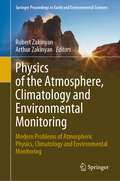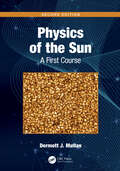- Table View
- List View
Physics of War: From Arrows to Atoms
by Barry ParkerThis fascinating blend of popular science and military history examines the science of war, demonstrating the close connection between the discovery of basic physical principles and the development of weaponry over the ages. Physics has played a critical role in warfare since the earliest times. Barry Parker highlights famous battles of the past as well as renowned scientists and inventors such as Leonardo, Galileo, Newton, Maxwell, and Einstein whose work had an impact on the technology of combat. Mechanics and the laws of motion led to improved shell trajectories; gas dynamics proved important to the interior ballistics of rifles and cannons; and space exploration resulted in intercontinental missiles, spy satellites, and drone aircraft. Parker emphasizes the special discoveries that had revolutionary effects on the art of warfare: the Chinese invention of gunpowder, the development of firearms, the impact of the Industrial Revolution, the deployment of the airplane in the First World War, and in our era the unleashing of the enormous power inherent in nuclear fission and fusion.
Physics of Waves
by Mark A. Heald William C. ElmoreBecause of the increasing demands and complexity of undergraduate physics courses (atomic, quantum, solid state, nuclear, etc.), it is often impossible to devote separate courses to the classic wave phenomena of optics, acoustics, and electromagnetic radiation. This brief comprehensive text helps alleviate the problem with a unique overview of classical wave theory in one volume.By examining a sequence of concrete and specific examples (emphasizing the physics of wave motion), the authors unify the study of waves, developing abstract and general features common to all wave motion. The fundamental ideas of wave motion are set forth in the first chapter, using the stretched string as a particular model. In Chapter Two, the two-dimensional membrane is used to introduce Bessel functions and the characteristic features of waveguides. In Chapters Three and Four, elementary elasticity theory is developed and applied to find the various classes of waves that can be supported by a rigid rod. The impedance concept is also introduced at this point. Chapter Five discusses acoustic waves in fluids.The remainder of the book offers concise coverage of hydrodynamic waves at a liquid surface, general waves in isotropic elastic solids, electromagnetic waves, the phenomenon of wave diffraction, and other important topics. A special feature of this book is the inclusion of additional material designed to encourage the serious student to investigate topics often not covered in lectures. Throughout, the mathematics is kept relatively simple (mostly differential equations) and is accessible to advanced undergraduates with a year of calculus. In addition, carefully selected problems at the end of each section extend the coverage of the text by asking the student to supply mathematical details for calculations outlined in the section, or to develop the theory for related cases.Impressively broad in scope, Physics of Waves offers a novel approach to the study of classical wave theory -- a wide-ranging but thorough survey of an important discipline that pervades much of contemporary physics. The simplicity, breadth, and brevity of the book make it ideal as a classroom text or as a vehicle for self-study.
Physics of the Atmosphere, Climatology and Environmental Monitoring: Modern Problems of Atmospheric Physics, Climatology and Environmental Monitoring (Springer Proceedings in Earth and Environmental Sciences)
by Robert Zakinyan Arthur ZakinyanThis proceedings book presents a discussion by leading scientists and specialists of the latest scientific results, developed methods, technologies and technical means of research and pilot work in the field of geosciences and environmental management. An important task is to familiarize young specialists, teachers, graduate students and students with the current state and the latest world achievements in this field of knowledge. Currently, there is a rapid and significant climate change, which manifests itself not only in global warming, but also in noticeable changes in other atmospheric and climatic characteristics among others.
Physics of the Early Universe: Proceedings of the Thirty Sixth Scottish Universities Summer School in Physics, Edinburgh, July 24 - August 11 1989 (Scottish Graduate Series)
by Andrew T. Davies John A. PeacockThe last decade has witnessed a breathtaking expansion of ideas concerning the origin and evolution of the universe. Researchers in cosmology thus need an unprecedented wide background in diverse areas of physics. Bridging the gap that has developed, Physics of the Early Universe explains the foundations of this subject. This postgraduate-/research-level volume covers cosmology, gauge theories, the standard model, cosmic strings, and supersymmetry.
Physics of the Formation and Evolution of Galaxies: Multiwavelength Point of View (Springer Series in Astrophysics and Cosmology)
by Tsutomu T. TakeuchiThis book introduces various physical processes related to the formation and evolution of galaxies, such as gravitation, electromagnetism, statistical physics, condensed matter, non-equilibrium processes, and relativity. Real data are analyzed using statistical methods and theoretical understanding. These topics give students and researchers in other fields a cross-sectional, interdisciplinary review. In particular, the author puts a great emphasis on multi-wavelength observations and surveys, which are now fundamental to understand the physics of any kind of cosmological and galactic comprehensive study. This is the first book to look at multi-wavelength surveys from the view of both observation and theory. This book is intended to be a standard guide to the physics of galaxy formation and evolution, which is popular in astrophysics but is not dealt with in detail in other books for young graduate students and non-experts in physics. Physical processes related to the formation and evolution of stars in galaxies are particularly mentioned from the view of multi-wavelength observations, which leads to an understanding of how the current universe has developed.
Physics of the Future: How Science Will Shape Human Destiny and Our Daily Lives by the Year 2100
by Michio KakuNATIONAL BESTSELLER • The renowned theoretical physicist and national bestselling author of The God Equation details the developments in computer technology, artificial intelligence, medicine, space travel, and more, that are poised to happen over the next century. &“Mind-bending…. [An] alternately fascinating and frightening book.&” —San Francisco ChronicleSpace elevators. Internet-enabled contact lenses. Cars that fly by floating on magnetic fields. This is the stuff of science fiction—it&’s also daily life in the year 2100.Renowned theoretical physicist Michio Kaku considers how these inventions will affect the world economy, addressing the key questions: Who will have jobs? Which nations will prosper? Kaku interviews three hundred of the world&’s top scientists—working in their labs on astonishing prototypes. He also takes into account the rigorous scientific principles that regulate how quickly, how safely, and how far technologies can advance. In Physics of the Future, Kaku forecasts a century of earthshaking advances in technology that could make even the last centuries&’ leaps and bounds seem insignificant.
Physics of the Human Body
by Irving P. HermanThis book comprehensively addresses the physics and engineering aspects of human physiology by using and building on first-year college physics and mathematics. Topics include the mechanics of the static body and the body in motion, the mechanical properties of the body, muscles in the body, the energetics of body metabolism, fluid flow in the cardiovascular and respiratory systems, the acoustics of sound waves in speaking and hearing, vision and the optics of the eye, the electrical properties of the body, and the basic engineering principles of feedback and control in regulating all aspects of function. The goal of this text is to clearly explain the physics issues concerning the human body, in part by developing and then using simple and subsequently more refined models of the macrophysics of the human body. Many chapters include a brief review of the underlying physics. There are problems at the end of each chapter; solutions to selected problems are also provided. This second edition enhances the treatments of the physics of motion, sports, and diseases and disorders, and integrates discussions of these topics as they appear throughout the book. Also, it briefly addresses physical measurements of and in the body, and offers a broader selection of problems, which, as in the first edition, are geared to a range of student levels. This text is geared to undergraduates interested in physics, medical applications of physics, quantitative physiology, medicine, and biomedical engineering.
Physics of the Human Body
by Richard P. McCallRichard P. McCall's fascinating book explains how basic concepts of physics apply to the fundamental activities and responses of the human body, a veritable physics laboratory. Blood pumping through our veins is a vital example of Poiseuille flow; the act of running requires friction to propel the runner forward; and the quality of our eyesight demonstrates how properties of light enable us to correct near- and far-sightedness. Each chapter discusses a fundamental physics concept and relates it to the anatomy and physiology of applicable parts of the body. Topics include motion, fluids and pressure, temperature and heat, speech and hearing, electrical behaviors, optics, biological effects of radiation, and drug concentrations. Clear and compelling, with a limited amount of math, McCall's descriptions allow readers of all levels to appreciate the physics of the human physique. Physics of the Human Body will help curious high school students, undergraduates with medical aspirations, and practicing medical professionals understand more about the underlying physics principles of the human body.
Physics of the Human Mind
by Ihor LubashevskyThis book tackles the challenging question which mathematical formalisms and possibly new physical notions should be developed for quantitatively describing human cognition and behavior, in addition to the ones already developed in the physical and cognitive sciences. Indeed, physics is widely used in modeling social systems, where, in particular, new branches of science such as sociophysics and econophysics have arisen. However, many if not most characteristic features of humans like willingness, emotions, memory, future prediction, and moral norms, to name but a few, are not yet properly reflected in the paradigms of physical thought and theory. The choice of a relevant formalism for modeling mental phenomena requires the comprehension of the general philosophical questions related to the mind-body problem. Plausible answers to these questions are investigated and reviewed, notions and concepts to be used or to be taken into account are developed and some challenging questions are posed as open problems. This text addresses theoretical physicists and neuroscientists modeling any systems and processes where human factors play a crucial role, philosophers interested in applying philosophical concepts to the construction of mathematical models, and the mathematically oriented psychologists and sociologists, whose research is fundamentally related to modeling mental processes.
Physics of the Human Temporality: Complex Present (Understanding Complex Systems)
by Ihor Lubashevsky Natalie PlavinskaThis book presents a novel account of the human temporal dimension called the “human temporality” and develops a special mathematical formalism for describing such an object as the human mind. One of the characteristic features of the human mind is its temporal extent. For objects of physical reality, only the present exists, which may be conceived as a point-like moment in time. In the human temporality, the past retained in the memory, the imaginary future, and the present coexist and are closely intertwined and impact one another.This book focuses on one of the fragments of the human temporality called the complex present. A detailed analysis of the classical and modern concepts has enabled the authors to put forward the idea of the multi-component structure of the present. For the concept of the complex present, the authors proposed a novel account that involves a qualitative description and a special mathematical formalism. This formalism takes into account human goal-oriented behavior and uncertainty in human perception.The present book can be interesting for theoreticians, physicists dealing with modeling systems where the human factor plays a crucial role, philosophers who are interested in applying philosophical concepts to constructing mathematical models, and psychologists whose research is related to modeling mental processes.
Physics of the Impossible: A Scientific Exploration into the World of Phasers, Force Fields, Teleportation, and Time Travel
by Michio KakuNATIONAL BESTSELLER • Inspired by the fantastic worlds of Star Trek, Star Wars, and Back to the Future, the renowned theoretical physicist and national bestselling author of The God Equation takes an informed, serious, and often surprising look at what our current understanding of the universe's physical laws may permit in the near and distant future.Teleportation, time machines, force fields, and interstellar space ships—the stuff of science fiction or potentially attainable future technologies? Entertaining, informative, and imaginative, Physics of the Impossible probes the very limits of human ingenuity and scientific possibility.
Physics of the Interstellar and Intergalactic Medium
by Bruce T. DraineThis is a comprehensive and richly illustrated textbook on the astrophysics of the interstellar and intergalactic medium--the gas and dust, as well as the electromagnetic radiation, cosmic rays, and magnetic and gravitational fields, present between the stars in a galaxy and also between galaxies themselves.Topics include radiative processes across the electromagnetic spectrum; radiative transfer; ionization; heating and cooling; astrochemistry; interstellar dust; fluid dynamics, including ionization fronts and shock waves; cosmic rays; distribution and evolution of the interstellar medium; and star formation. While it is assumed that the reader has a background in undergraduate-level physics, including some prior exposure to atomic and molecular physics, statistical mechanics, and electromagnetism, the first six chapters of the book include a review of the basic physics that is used in later chapters. This graduate-level textbook includes references for further reading, and serves as an invaluable resource for working astrophysicists.Essential textbook on the physics of the interstellar and intergalactic medium Based on a course taught by the author for more than twenty years at Princeton University Covers radiative processes, fluid dynamics, cosmic rays, astrochemistry, interstellar dust, and more Discusses the physical state and distribution of the ionized, atomic, and molecular phases of the interstellar medium Reviews diagnostics using emission and absorption lines Features color illustrations and detailed reference materials in appendices Instructor's manual with problems and solutions (available only to teachers)
Physics of the Invisible Sun: Instrumentation, Observations, and Inferences
by Ashok AmbasthaPhysics of the invisible Sun: Instrumentation, Observations, and Inferences provides a new updated perspectives of the dramatic developments in solar physics mainly after the advent of the space era. It focusses on the instrumentation exploiting the invisible windows of the electromagnetic spectrum for observing the outer, fainter layers of the Sun. It emphasizes on the several technical and observational challenges and proceeds to discuss the discoveries related to energetic phenomena occurring in the transition region and corona. The book begins with giving a brief glimpse of the historical developments during the pre-, and post-telescopic periods of visible and spectroscopic techniques, ground-based optical and radio observing sites. Various types of telescopes and back-end instrumentation are presented based on photometry, spectroscopy, and polarimetry using the Zeeman and Hanle effects for measurement of magnetic fields, and Doppler effect for radial velocity measurements. The book discusses theoretical and observational inferences based on detection of solar neutrinos, and helioseismology as the probes of the hidden solar interior, and tests of solar standard models. The characteristic properties and observational signatures of global solar p- and g-oscillations modes, developments in local helioseismology and asteroseismology are discussed. The role of the solar magnetic field and differential rotation in the activity and magnetic cycles, prediction methodologies, and dynamo models are described. Observing the Sun in IR at the longer, and the UV, EUV, XUV, X-rays, and gamma-rays at the shorter wavelengths are covered in detail. Observational challenges at each of these wavelengths are presented followed by the instrumentation for detection and imaging that have resulted in enhancing the understanding of various solar transient phenomena, such as, flares and CMEs. The outer most corona is described as a dynamic, expanding component of the Sun from the theoretical and observational perspectives of the solar wind. It then discusses the topics of the Interplanetary magnetic field, slow and fast solar wind, interaction with magnetised and non-magnetised objects of the solar system, the space weather and the physics of the heliosphere. The chapter on the future directions in solar physics presents a brief overview of the new major facilities in various observing windows, and the future possibilities of observing the Sun from ground and vantage locations in space. Features: Systematic overview of the developments in instrumentation, observational challenges and inferences derived from ground-based and space-borne solar projects. Advances in the understanding about the solar interior from neutrinos and helioseismology. Recent research results and future directions from ground- and space-based observations. This book may serve as a reference book for scientific researchers interested in multi-wavelength instrumentation and observational aspects of solar physics. It may also be used as a textbook for a graduate-level course.
Physics of the Life Sciences
by Jay NewmanEach chapter has three types of learning aides for students: open-ended questions, multiple-choice questions, and quantitative problems. There is an average of about 50 per chapter. There are also a number of worked examples in the chapters, averaging over 5 per chapter, and almost 600 photos and line drawings.
Physics of the Plasma Universe
by Anthony L. PerattToday many scientists recognize plasma as the key element to understanding new observations in near-Earth, interplanetary, interstellar, and intergalactic space; in stars, galaxies, and clusters of galaxies, and throughout the observable universe. Physics of the Plasma Universe, 2nd Edition is an update of observations made across the entire cosmic electromagnetic spectrum over the two decades since the publication of the first edition. It addresses paradigm changing discoveries made by telescopes, planetary probes, satellites, and radio and space telescopes. The contents are the result of the author's 37 years research at Livermore and Los Alamos National Laboratories, and the U. S. Department of Energy. This book covers topics such as the large-scale structure and the filamentary universe; the formation of magnetic fields and galaxies, active galactic nuclei and quasars, the origin and abundance of light elements, star formation and the evolution of solar systems, and cosmic rays. Chapters 8 and 9 are based on the research of Professor Gerrit Verschuur, and reinvestigation of the manifestation of interstellar neutral hydrogen filaments from radio astronomical observations are given. Using data from the Green Bank 100-m telescope (GBT) of the National Radio Astronomy Observatory (NRAO), detailed information is presented for a non-cosmological origin for the cosmic microwave background quadruple moment. This volume is aimed at graduate students and researchers active in the areas of cosmic plasmas and space science. The supercomputer and experimental work was carried out within university, National laboratory, Department of Energy, and supporting NASA facilities.
Physics of the Sun: A First Course
by Dermott J. MullanWith an emphasis on numerical modelling, Physics of the Sun: A First Course presents a quantitative examination of the physical structure of the Sun and the conditions of its extended atmosphere. It gives step-by-step instructions for calculating the numerical values of various physical quantities in different regions of the Sun. Fully updated throughout, with the latest results in solar physics, this second edition covers a wide range of topics on the Sun and stellar astrophysics, including the structure of the Sun, solar radiation, the solar atmosphere, and Sun-space interactions. It explores how the physical conditions in the visible surface of the Sun are determined by the opacity of the material in the atmosphere. It also presents the empirical properties of convection in the Sun, discusses the physical conditions which must be satisfied for nuclear reactions to occur in the core, and describes how radiation transports energy from the core outwards. This text enables a practical appreciation of the physical models of solar processes. Numerical modelling problems and step-by-step instructions are featured throughout, to empower students to calculate, using their own codes, the interior structure of different parts of the Sun and the frequencies of p-modes and g-modes. They encourage a firm grasp of the numerical values of actual physical parameters as a function of radial location in the Sun. It is an ideal introduction to solar physics for advanced undergraduate and graduate students in physics and astronomy, in addition to research professionals looking to incorporate modelling into their practises. Extensive bibliographies at the end of each chapter enable the reader to explore the latest research articles in the field. Features Fully updated with the latest results from the spacecraft Hinode, Stereo, Solar Dynamics Observatory (SDO), Interface Region Imaging Spectrograph (IRIS), and Parker Solar Probe Presents step-by-step explanations for calculating numerical models of the photosphere, convection zone, and radiative interior with exercises and simulation problems to test learning Describes the structure of polytropic spheres and the acoustic power in the Sun and the process of thermal conduction in different physical conditions
Physics of the Terrestrial Environment, Subtle Matter and Height of the Atmosphere: Conceptions of the Atmosphere and the Nature of Air in the Age of Enlightenment
by Eric ChassefiereThe discovery, in the middle of the 17th century, of both the weight of air and the law governing its elasticity transformed the status of the atmosphere from that of a purely mathematical object to that of a complex and highly variable physical system.In the context of rapidly intensifying experimentation and observation, the nature of the atmosphere was therefore the subject of a host of hypotheses, which 18th century scholars tried to reconcile with a coherent physical approach. In particular, this was achieved by the conceptualization of invisible or “subtle” materials, thought to be closely linked to atmospheric stratification.Subtle matter was introduced, largely to reconcile contradictory results concerning the estimation of the height of the atmosphere. These estimations were based on different methods, mainly using the observation of meteors and the refracted and reflected light of stars.Taking as its common thread the question of the height of the atmosphere, which was omnipresent in the texts at the time, this book traces the history of the discovery of the atmosphere and the many questions it generated.
Physics to a Degree
by E.G. Thomas Derek RainePhysics to a Degree provides an extensive collection of problems suitable for self-study or tutorial and group work at the level of an undergraduate physics course. This novel set of exercises draws together the core elements of an undergraduate physics degree and provides students with the problem solving skills needed for general physics' examinations and for real-life situations encountered by the professional physicist. Topics include force, momentum, gravitation, Bernoulli's Theorem, magnetic fields, blackbody radiation, relativistic travel, mechanics near the speed of light, radioactive decay, quantum uncertainty, and much more.
Physics with Excel and Python: Using the Same Data Structure Volume I: Basics, Exercises and Tasks
by Dieter MergelThis book is intended to serve as a basic introduction to scientific computing by treating problems from various areas of physics - mechanics, optics, acoustics, and statistical reasoning in the context of the evaluation of measurements. After working through these examples, students are able to independently work on physical problems that they encounter during their studies. For every exercise, the author introduces the physical problem together with a data structure that serves as an interface to programming in Excel and Python. When a solution is achieved in one application, it can easily be translated into the other one and presumably any other platform for scientific computing. This is possible because the basic techniques of vector and matrix calculation and array broadcasting are also achieved with spreadsheet techniques, and logical queries and for-loops operate on spreadsheets from simple Visual Basic macros. So, starting to learn scientific calculation with Excel, e.g., at High School, is a targeted road to scientific computing. The primary target groups of this book are students with a major or minor subject in physics, who have interest in computational techniques and at the same time want to deepen their knowledge of physics. Math, physics and computer science teachers and Teacher Education students will also find a companion in this book to help them integrate computer techniques into their lessons. Even professional physicists who want to venture into Scientific Computing may appreciate this book.
Physics with Photons Using the ATLAS Run 2 Data: Calibration and Identification, Measurement of the Higgs Boson Mass and Search for Supersymmetry in Di-Photon Final State (Springer Theses)
by Stefano ManzoniThe work presented in this book is based on the proton-proton collision data from the Large Hadron Collider at a centre-of-mass energy of 13 TeV recorded by the ATLAS detector in 2015 and 2016. The research program of the ATLAS experiment includes the precise measurement of the parameters of the Standard Model, and the search for signals of physics beyond the SM. Both these approaches are pursued in this thesis, which presents two different analyses: the measurement of the Higgs boson mass in the di-photon decay channel, and the search for production of supersymmetric particles (gluinos, squarks or winos) in a final state containing two photons and missing transverse momentum. Finally, ATLAS detector performance studies, which are key ingredients for the two analyses outlined before, are also carried out and described.
Physics, 8th edition
by John D. Cutnell Kenneth W. Johnson Kent D. FisherDesigned for medical professionals who may struggle with making the leap to conceptual understanding and applying physics, the eighth edition continues to build transferable problem-solving skills. It includes a set of features such as Analyzing-Multiple-Concept Problems, Check Your Understanding, Concepts & Calculations, and Concepts at a Glance. This helps the reader to first identify the physics concepts, then associate the appropriate mathematical equations, and finally to work out an algebraic solution. They'll also be able to work high quality problem sets and gain immediate feedback through WileyPLUS, the online problem-solving management system. New Focus on Concept questions are featured in WileyPLUS, offering medical professionals a set of thought provoking conceptual questions as well as calculation problems.
Physics, AP* Edition (3rd Edition)
by James S. WalkerPhysics determines the behavior of everything in the universe--from the particles that make up atoms, to the tissues of the human body, to galaxies and the multitude of stars they contain. Grouped in pairs that share a common physical theme, these images touch on just a few of the many real-world applications of physics discussed in this text. As you study the material in this book, your understanding of physics will deepen. You will begin to make the connection between magnets and MRI, organ pipes and windpipes, lighthouses and magnifying glasses, hurricanes and galaxies. At the same time, your appreciation for the world around you will increase as you come to recognize the fundamental physical principles on which all of our lives are based.
Physics, Nature and Society
by Joaquín MarroThis wide-ranging and accessible book serves as a fascinating guide to the strategies and concepts that help us understand the boundaries between physics, on the one hand, and sociology, economics, and biology on the other. From cooperation and criticality to flock dynamics and fractals, the author addresses many of the topics belonging to the broad theme of complexity. He chooses excellent examples (requiring no prior mathematical knowledge) to illuminate these ideas and their implications. The lively style and clear description of the relevant models will appeal both to novices and those with an existing knowledge of the field.
Physics, Nature and Society: A Guide to Order and Complexity in Our World (The Frontiers Collection)
by Joaquín MarroThis wide-ranging and accessible book serves as a fascinating guide to the strategies and concepts that help us understand the boundaries between physics, on the one hand, and sociology, economics, and biology on the other. From cooperation and criticality to flock dynamics and fractals, the author addresses many of the topics belonging to the broad theme of complexity. He chooses excellent examples (requiring no prior mathematical knowledge) to illuminate these ideas and their implications. The lively style and clear description of the relevant models will appeal both to novices and those with an existing knowledge of the field.
Physics, Pharmacology and Physiology for Anaesthetists
by Matthew E. Cross Emma PlunkettA key requirement of the primary and final FRCA examinations is a sound understanding of the basic sciences behind anaesthetic practice. It is important to be able to describe these principles clearly, particularly in the viva section of the examinations. This fully updated new edition of a key title in the field of anaesthesia provides all the important graphs, definitions and equations which may be covered in the examinations, together with clear and concise explanations of how to present them to the examiner and why they are important. Packed full of precise, clear diagrams with well structured explanations, and with all key definitions, derivations and statistics, this is an essential study aid for all FRCA examination candidates.























